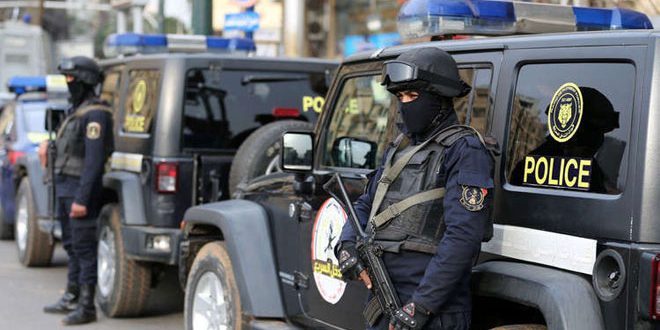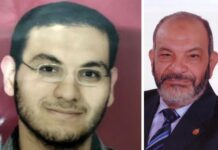According to the former Minister of Interior, Major General Habib al-Adly, the Central Security Sector is “the military wing and strike force of the Egyptian police.” Since its establishment in 1969, the sector has played a prominent role in public, especially in protecting the ruling regimes by confronting mass protests, carrying out arrests of political opponents, securing election fraud, in addition to its technical role of guarding vital facilities and assisting the rest of police sectors in tasks such as storming the hideouts of drug trafficking gangs and supporting police campaigns against violators. Despite the importance of the Central Security Forces role, there is no published and detailed study on it, in either Arabic or English. From here stems the significance of The Corridors of Central Security: Origin and Components (1969-2011), written by Ahmed Maulana, a researcher in security affairs, published last January. The Corridors of Central Security aims to address the Central Security Sector and the motives for its establishment, its organisational structure, how its personnel are recruited, its actual strength, the nature of the relationship between it and the Security Forces Sector, and the roles it plays.
The Emergence of the Central Security Forces
In February 1968, mass student demonstrations against the ruling regime broke out in Egypt for the first time since the coup of July 23, 1952, after the issuance of reduced sentences against the Air Force officers accused of negligence in the 1967 war. In light of the inability of the Security Forces to curb the demonstrations, President Gamal Abdel Nasser used the army and its helicopters to disperse the demonstrations.
After the suppression of this movement, the Nasserite regime worked to establish a light-duty and well-armed police force specialised in confronting local unrest in cooperation with the security sectors. Thus, Major General Kamal Khairallah was entrusted with training 8,000 recruits from the Security Forces in Cairo. After the end of the training, a decision was issued in August 1969 to form the Central Reserve of the Ministry of Interior. Manpower reached 189 officers and 11,690 soldiers under the supervision of the Undersecretary of the Ministry of Interior for Training and Personnel Affairs, and the Central Reserve was stationed in both Cairo and Alexandria.
According to a number of the founders of the Central Security Sector, the idea of establishing the apparatus in its present form arose after they saw in Paris two French brigades created to maintain security: one of them is the Compagnies Républicaines de Sécurité (CRS), which is very similar to the Central Security Forces in Egypt, and the second is the Gendarmerie, which is a military force with law enforcement duties among the civilian population, working in times of peace under the command of the Minister of Interior. In times of war, it submits to the orders of the Minister of War. The CRS forces are the general reserve of the French National Police and work as mobile units organised in the form of military formations that deal with large-scale mass movements such as demonstrations and riots. In fact, the CRS forces were established under the Vichy government during the Nazi occupation of France.
During the era of former President Mohamed Anwar Sadat, and in light of the armed forces’ preoccupation with rebuilding their military capabilities after the 1967 defeat, the CRF were considered the second line of defence on the home front. The central reserve was used in securing the canal cities as a quick rescue force for vital facilities if they were exposed to danger, as well as securing the entrances to Cairo against any Israeli air attacks. The deployment of the central reserve was expanded outside Cairo, Alexandria and the canal region through the establishment of the Assiut region, whose centre is the city of Assiut, and the central Delta Region, whose centre is the city of Tanta.
After the end of the October 1973 War, and the decline in the need for the central reserve in the canal region, Sadat issued a republican decree to establish the General Administration of Central Reserve Forces, which is concerned with maintaining security from any disturbance, and assisting police forces in security directorates, and the central reserve formed its nucleus. According to this decree, the new public administration became affiliated with the Assistant Minister for Public Security. Then, in 1976, a republican decree was issued to upgrade the director of the General Administration of the Central Reserve to the rank of Assistant Minister of Interior, indicating the importance of the Central Reserve from the perspective of the Sadat regime.
The January uprising of 1977: A turning point
With the deterioration of economic conditions following the open door policy adopted by Sadat, the public could not bear the government’s announcement of an increase in the prices of basic commodities in January 1977. On January 18 and 19, massive demonstrations and acts of violence broke out in Cairo and Alexandria, which quickly extended to include nine governorates in events that represented a serious challenge for the Sadat regime. The security forces were unable to pursue the events and their repercussions, which prompted Sadat to seek the help of the army to restore order to the streets.
After the end of the January events, Sadat asked the former commander of the central reserve, Major General Kamal Khairallah, to reconfigure the central reserve forces to ensure their ability to confront popular demonstrations. Khairallah developed a plan based on the deployment of the forces in strategic locations in all parts of the country, including Cairo, Tanta, Marsa Matrouh, Alexandria and Assiut, so that the total number of these forces would reach 30,000 recruits without increasing the number under any circumstances in order to facilitate their training and control.
But, in December 1977, Khairallah was transferred to another position, and the number of forces increased to 110,000 recruits, an unprecedented increase that made the central reserve turn into an army controlled by the Ministry of Interior. This is reflected in the allocation of large resources that burden the country and include the establishment of a huge infrastructure that includes camps, logistics, accommodation operations, armament and training. The forces were also armed for the first time with heavy weapons and armoured vehicles.
After the assassination of Sadat in 1981, Hosni Mubarak assumed the presidency of Egypt and the Ministry of Interior was restructured due to its failure to anticipate the assassination. Within the framework of the security restructuring plan, Mubarak issued in 1984 a republican decree stipulating that the name of the General Administration of Central Reserve Forces be modified to become the General Administration for the Presidency of Central Security Forces, and seven central security departments were established covering all parts of Egypt, to ensure that the regime was able to confront any dangers threatening the security situation of the regime or its new president, and Central Security has thus become the first line of defence for the ruling regime. The Central Security Forces are currently composed of 10 departments, in addition to the Counter-Terrorism Unit, which was established in 2018.
Illiteracy: A criterion for joining the central security forces
Police personnel are recruited from citizens wanted for military service in accordance with the provisions of Law No. 127 of 1980 regarding military and national service. According to this law, all of the following are exempt from police service: graduates of universities and higher institutes in Egypt or their equivalent abroad, those with intermediate certificates, or any other equivalent certificates from abroad, and those who completely memorise the Qur’an.
As a consequence, the police recruited illiterate individuals who were more receptive to carrying out orders without discussion, and less aware of human rights and the political contexts of events. The presence of police recruits from Cairo or provincial capitals is rare, given the high rates of education in those places. Regularly, people who failed to pass the entrance exams in the ranks of the armed forces are selected also for recruitment in the Central Security. Though called the “fourth row” due to their weak skills and mental abilities, they meet the health conditions for joining the Ministry of Interior.
In 2009, the Military and National Service Law was amended to allow the above-excluded groups to be recruited into the police by a decision of the Minister of Defence at the request of the Minister of Interior, and not exceeding 10 per cent of the number of recruits in the Ministry of Interior, after completing the needs of the armed forces from these groups. However, the percentage of recruits in the Ministry of Interior remained minimal and with very limited qualifications, which ensured that the structure and culture of police recruits did not change.
The period of conscription in the police is three years, during which the recruiter spends the first six months in elementary training, learning discipline and carrying weapons, and then engages in performing his duties. With regard to salaries, it was characterised as a severe weakness, as the monthly salary of the recruiter in 2011 reached about EGP 220, less than $40 at the prices of that period, an amount that is not sufficient for food and drink in light of the insufficient meals offered at the barracks. As for the work and rest periods, they are divided so that the soldier spends 20 days at work and then takes ten days off.
With regard to central security officers, they are selected according to a numerical quota allocated from each police batch, as they are usually those who have poor grades during the period of their studies or those who do not have personal relationships that allow them to be appointed in more attractive places such as the Passports, Emigration & Nationality Administration and State Security offices. Upon their graduation, officers nominated for central security will receive a three-month training course that includes theoretical and practical training on day and night operations. These courses are similar to the training of the armed forces.
As for the relationship between conscripts and officers in Central Security, a number of points should be noted. With the adoption of conscription in Egypt, the performance of military service has repercussions on the life path of young people. Due to the very limited number of university-educated police soldiers, the largest segment of soldiers are from the poorest and least-educated classes, as most of them work in agriculture and handicrafts, and they usually contribute to bearing the living costs of their families in terms of food, drink and food.
Consequently, when they are recruited to perform military service for a period of three years, and receive very low salaries, they live under great psychological and financial pressure. They also consider that this period drains them financially, delays their marriage, and they wait impatiently for the day of the end of their military service.
In light of the previous data and the officers’ treatment of soldiers, deaths among conscripts are frequent in the central security camps. While the Ministry of Interior attributes these incidents to suicides, the families of the victims attribute them to retaliatory killings of their children at the hands of officers, which was covered in a BBC documentary that follows the incidents of the killing of 13 recruits during the period from 2008 to 2015. On the other hand, February 2014 witnessed a unique incident in which a recruiter stabbed a Captain in the Central Security Sector in Dahshour, Giza, after the officer insulted the recruiter, according to some circulating accounts.
The components of the central security sector
The structure of the Central Security Forces is largely identical to the military structure of the army forces, as it includes battalions, companies, and factions. Headed by a Major General with the rank of assistant/first assistant Minister of Interior, the Central Security consists of officers, delegates, recruits, and a smaller number of police secretaries and civilians who carry out administrative work.
The central security is divided into 10 public administrations according to a geographical division that includes the various parts of the country, in addition to a specific division that includes Special Operations Forces. The armament of the Central Security Forces varies from electric sticks to armoured vehicles, and heavy machine guns. With regard to training, there are specialised training institutes in the general, geographical and specific administrations in the sector, in addition to an institute for training officers that provides specialised training as well as an integrated training village which is 90 acres on the Cairo-Alexandria Desert Road.
Due to the centrality of Cairo and Giza in securing the ruling regime, the Ministry of Interior was keen to establish central security camps on the outskirts of the capital so that forces would flow from them for any security emergency.
Each central security camp includes several sectors, and the size varies from one sector to another. In some cases, the sector consists of only one battalion, and some of it consists of two battalions, reaching a maximum of four battalions in one sector. In the case of the sector, which consists of three battalions, it includes a battalion called the Support Battalion, which is trained to use firearms, in addition to two battalions specialised in riot dispersal, each of which consists of four companies, and one of them receives training of the same type as the training of the Support Battalion in order to assist the latter in case it needs reinforcements.
Each sector is usually headed by an officer with the rank of Major General, and with each sector consisting of three battalions, each battalion is headed by a Lieutenant Colonel. One battalion is divided into four companies. One riot dispersal battalion consists of three factions, and each faction has up to 30 recruits. In total, the number of members in a single battalion usually ranges from 250 to 360 soldiers, while the number of officers in a battalion ranges from 11 to 16 officers.
The number of Central Security Forces in 2011 was about 120,000, according to the testimony of the First Assistant Minister of Interior for the Security Forces Sector at the time, Major General Hassan Abdel Hamid.
The role of the central security forces in the January 25 revolution
The report of the Commission of Inquiry into the Events of the January Revolution revealed the nature of the Central Security role in confronting the demonstrations. In each governorate, the Director of Security was responsible for developing a plan to confront the demonstrations within the scope of his supervision. While all security directors in the governorates, except Cairo, were subject to the supervision of the assistant minister for security, the Director of Security in Cairo was the first field official in the capital for fighting demonstrations in coordination with the Assistant Minister for the Central Security Sector.
During the January revolution, the Director of Security in Cairo established a mobile operations room to follow up on the demonstrations, and the Ministry of Interior implemented the 100th plan for riot dispersal. As for the person in charge of issuing the decision to shoot the demonstrators, it was according to the following sequence: the Minister of Interior personally, then the Director of Security, and the Assistant Minister for Central Security.
During the events of January 2011, there were 17,000 recruits in the Central Security Forces in Cairo. Groups of the Central Security Forces dressed in civilian clothes, called Civilian Dispersal Units, were the most efficient in arresting demonstrators. One group usually consists of ten soldiers.
According to its former head, Major General Hassan Abdel Rahman, State Security Investigations had estimated that 5,000 demonstrators would participate in the January 28 demonstrations, and, accordingly, a plan to confront the demonstrations was drawn up.
However, the Ministry of Interior was surprised by the participation of huge numbers of demonstrators for several days, which exhausted the Central Security Forces that ran out of ammunition and worked for several days without rest, leading to the depletion of batteries charging wireless devices in parallel with cutting telephone communication networks, which impeded communication between the forces and its leaders. Consequently, with the suspension of support for the forces, the field formations withdrew from their positions.
In parallel, the Ministry of Interior was paralysed, as the demonstrators targeted police stations, including 28 police stations in Cairo, in addition to storming Abu Zaabal, Al Marj, Wadi al-Natroun and Fayoum prisons, and the escape of around 20,000 prisoners and detainees.
According to a report provided by the Ministry of Interior to the Commission of Inquiry into the events of the January Revolution, between 25 and 31 January 2011, 827 people were killed, including: 679 citizens, 110 prisoners, and 38 policemen, including six officers. Also during the demonstrations, 1,276 policemen were injured, while 2,423 police vehicles were set fire to, and 191 vehicles were stolen. The Ministry of Interior lost 2,009 automatic rifles, and nearly 10,000 handguns. The collapse and withdrawal of the Central Security Forces led to the collapse of the Ministry of Interior.









